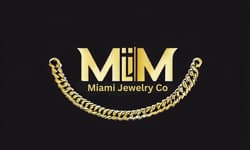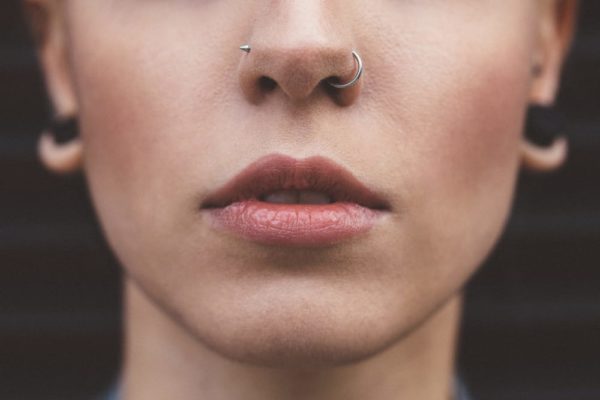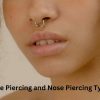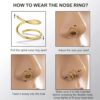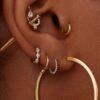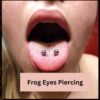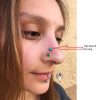Nose Piercing
When Can I Change My Nose Piercing After Getting It Pierced?
Nose piercings are causing a stir in the fashion world. They add a unique touch to any look. Whether you choose a simple stud or a bold hoop, one question often pops up: “When can I change my nose piercing?” The excitement to try new styles is natural, but your piercing’s health and healing must come first.
In this piece, we explore when it’s safe to change your nose piercing. We also offer aftercare tips for a healthy, smooth transition. If you’re eager to start experimenting with styles, join us as we navigate this important post-piercing stage.
Contents
- 1 Key Takeaways
- 2 Understanding Nose Piercings
- 3 The Healing Process of a Nose Piercing
- 4 When to Change Your Nose Piercing
- 5 How to Change Your Nose Piercing
- 6 Understanding the Risks of Changing a NoseRing
- 7 Tips for Nose Piercing Aftercare
- 8 FAQs
- 9 Final Words – When Can I Change My Nose Piercing After Getting it Pierced
Key Takeaways
- Wait time: You usually need to wait 2 to 4 months after a nose piercing before changing it. This can be different for everyone and the type of jewelry you use.
- Check your piercing: A healed piercing will not be red, swollen, or painful. There won’t be any liquid coming out of it. Make sure to check for these signs.
- Talk to a pro: Always ask a professional piercer before you change your jewelry. Do this especially if you’re not sure about how well your piercing has healed.
- Choose your jewelry: Some metals can make your skin react badly. You should use jewelry made from stuff like titanium, surgical steel, or gold.
- Keep it clean: It’s very important to clean your nose piercing regularly while it’s healing. This helps prevent infection.
- Don’t change too much: Once your piercing is healed, don’t change the jewelry a lot. This can bother the piercing and make it take even longer to heal.
- Patience: Be patient while your nose piercing is healing. If you change the jewelry too soon, it can cause problems like infection or tearing.
Understanding Nose Piercings
While nose piercings have gained popularity in recent years, they are far from a new trend. Nose piercings have a rich history spanning thousands of years and across different cultures. Today, there are a variety of styles and placements to choose from. Let’s delve into the most common types.
Nostril Piercing
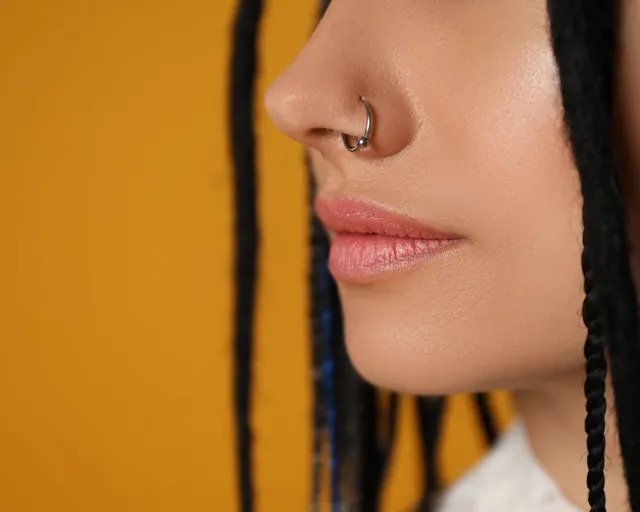
The nostril piercing is the most common type. It involves a single piercing on either the left or right nostril. This piercing’s location is typically at the curve of the nostril, where the nose starts to narrow towards the tip. The jewelry you choose can be a small stud or a nose ring.
Related: Nose Rings Hoops
Septum Piercing
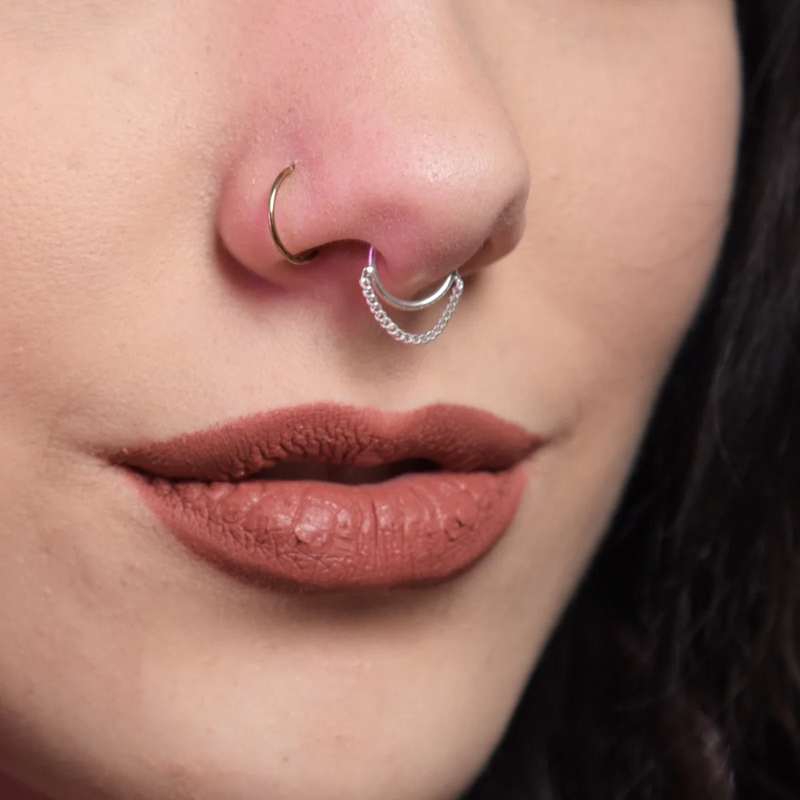
A septum piercing is often thought of as a more alternative choice. This piercing goes through the small gap between the cartilage and the bottom of the nose, known as the “sweet spot.” The jewelry for a septum piercing is usually a ring that fits around the nostrils inside the nose.
High Nostril Piercing
A high nostril piercing is similar to a standard nostril piercing but placed higher up on the nose, near the nasal bridge. This placement is less common and may require a professional with specific experience in high nostril piercings. The jewelry for a high nostril piercing is usually a small stud.
The Healing Process of a Nose Piercing
Just like any wound, your body needs time to heal after a nose piercing. The healing process involves two main stages.
Initial Healing Stage
The initial healing stage, also known as the inflammatory stage, begins immediately after you get your nose pierced. This stage usually lasts 3-4 weeks, during which you may experience swelling, redness, heat, and minor bleeding or discharge. This is your body’s natural response and is a sign that your body is cleaning the wound and fighting off potential infections.
Secondary Healing Stage
After the initial healing stage, your body enters the secondary healing stage. This is when your body starts to form new skin and blood vessels in the piercing canal. This stage takes 2-4 months for most people. However, it’s important to remember that everyone’s body is different, and healing times can vary.
When to Change Your Nose Piercing
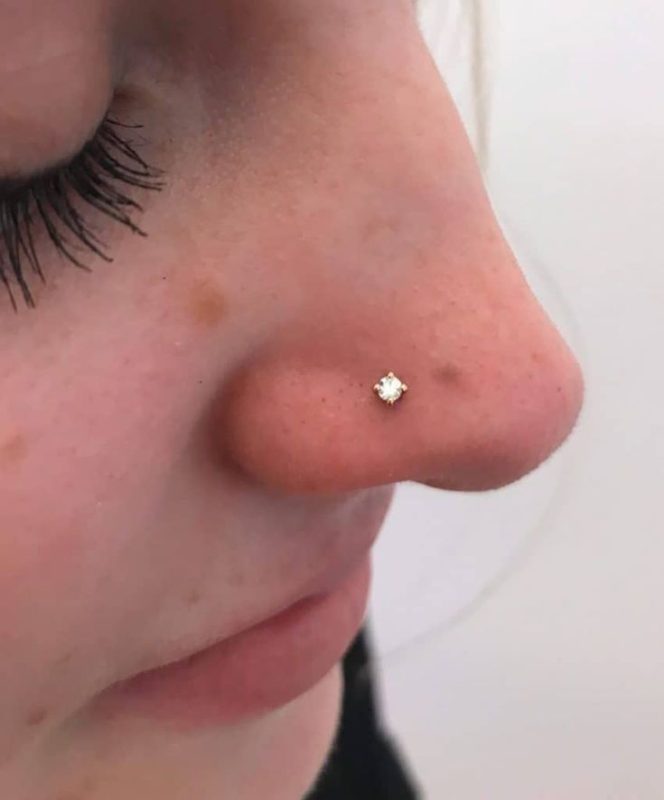
Changing your nose piercing isn’t something you should rush. It’s crucial to wait until your nose piercing has fully healed to avoid potential complications.
Signs Your Piercing Has Healed
Knowing the signs that your piercing has healed can help you determine when it’s safe to change your jewelry. A fully healed piercing will have no pain, redness, or swelling. The skin around the piercing will look healthy, and the hole will be fully formed.
Risks of Changing Your Piercing Too Early
Changing your piercing too early can lead to complications. When you remove the jewelry from an unhealed piercing, you risk tearing the healing tissue, which can cause pain and prolong the healing process. Additionally, the hole may start to close up quickly, and you might struggle to get the new jewelry in. The most severe risk is infection.
How to Change Your Nose Piercing
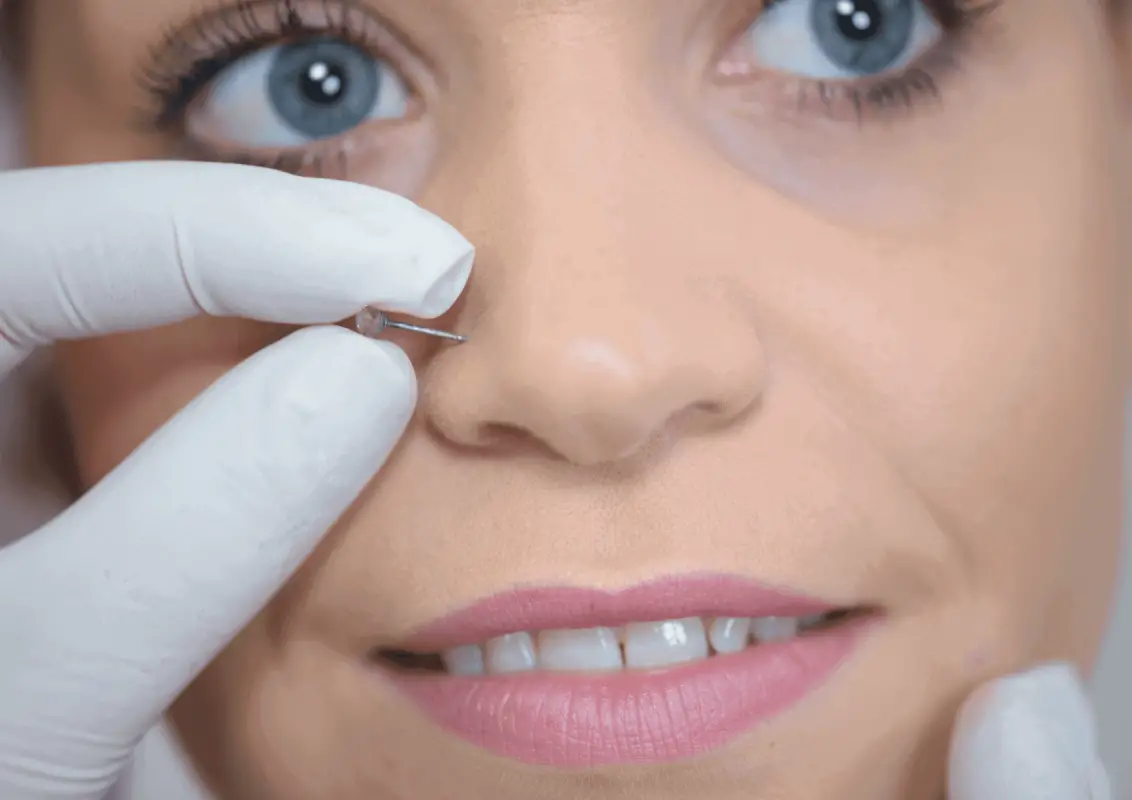
Once your piercing has healed, you can start thinking about changing your jewelry. Whether you’re looking for a style change or your piercing has healed, here’s how you can safely change your nose piercing.
Choosing the Right Jewelry
Choosing the right jewelry for your nose piercing is not just about style. You also need to consider the material of the jewelry, the size, and how easy it is to insert and remove. Surgical steel, titanium, and 14k gold are excellent choices as they are generally safe for most people. It’s crucial to avoid materials that can cause allergic reactions, such as nickel. The size of the jewelry should match the gauge of your piercing to ensure a proper fit.
The Process of Changing Your Piercing
Changing your nose piercing for the first time can feel a bit daunting, but with the right steps, it can be a straightforward process.
Clean your hands and the new jewelry:
Start by washing your hands thoroughly with antibacterial soap. Then clean your new jewelry with a saline solution.
Remove the old jewelry:
For nostril screws, gently twist and pull the jewelry out. For captive bead rings, you need to remove the bead first. It might help to use a mirror and take your time.
Insert the new jewelry:
Immediately after removing the old jewelry, insert the new piece. For a nostril screw, you’ll need to twist it in the opposite direction that you removed the old one.
Clean the piercing site:
Once you have successfully changed the jewelry, clean the piercing site with a saline solution to keep it clean.
Understanding the Risks of Changing a NoseRing
Your nose piercing is very sensitive, especially when it is healing. If you remove the stud too early, you might get an infection. You could also cause swelling or even bleeding.
Even when your nose has healed, you need to be careful. The piercing will be tight at first, so gently ease in the jewelry. If it doesn’t feel comfortable, don’t force it. You could hurt your nose. Also, don’t use jewelry that is too big or too small.
When you change your nose ring, make sure your hands and the new jewelry are clean. If they’re not, you could get an infection.
You Might Also Like
- Double Hoop Nose Ring
- Triple Nose Piercing
- How to Choose the Best Nose Ring According to Face Shape
- How to Wear Half Hoop Nose Ring
- How to Put in a Nose Ring with a Hook
- How to Take Out Nose Stud with Flat Back
- What Gauge Is a Nose Piercing
- High Nostril Piercing
Tips for Nose Piercing Aftercare
Looking after your nose piercing is the most critical step in ensuring a healthy healing process. Here are some aftercare tips to keep in mind.
Cleaning Your Piercing
It’s essential to clean your piercing regularly to keep it free from bacteria that could lead to infection. Use a saline solution, which you can buy in pharmacies or make at home with salt and water. Avoid using alcohol or hydrogen peroxide, as these can be too harsh and delay the healing process.
What to Avoid
There are a few things you should avoid while your nose piercing is healing:
Don’t play with your jewelry:
Touching your piercing can introduce bacteria and lead to infection.
Avoid swimming:
Swimming pools, hot tubs, lakes, and the ocean can all house bacteria that could infect your piercing.
Be careful with makeup and skincare products:
These can irritate the piercing. Try to keep these products away from the piercing site.
Avoid sleeping on your piercing:
This can cause irritation and prolong the healing process.
FAQs
How long does it take for a nose piercing to heal?
A nose piercing typically takes 2 to 4 months to fully heal. However, everyone’s body is different, and healing times can vary.
When can I change my stud to a hoop nose?
Changing your nose stud to a hoop should ideally be done once the piercing has fully healed. For most people, this will be between 2 to 4 months after getting the piercing. Changing to a hoop prematurely can lead to complications such as infection or trauma to the healing tissue.
Can I put a hoop in a fresh nose piercing?
It’s generally not recommended to put a hoop in a fresh nose piercing. A stud is usually the better choice for a new piercing as it moves less and creates less irritation, promoting a smoother healing process. Once your piercing is fully healed (typically after 2 to 4 months), you can safely switch to a hoop.
Can you put a nose ring in after 4 weeks?
While it might be tempting to change your nose jewelry after 4 weeks, it’s essential to wait until your piercing has fully healed. For most nose piercings, the healing process takes between 2 to 4 months. Changing your jewelry too early can lead to complications such as infection and can potentially prolong the healing process.
How do I know my nose piercing is healed?
A healed nose piercing will show several signs. Firstly, there should be no pain, swelling, or redness around the piercing site. The skin around the piercing will look healthy, and the piercing hole will be fully formed. If you’re unsure, it’s best to consult with a professional piercer to confirm whether your piercing is fully healed before changing the jewelry.
What happens if I change my nose piercing too early?
Changing your nose piercing too early can lead to complications such as infection or the piercing hole closing up. It could also cause pain and prolong the healing process.
What is the best material for nose jewelry?
Surgical steel, titanium, and 14k gold are considered safe materials for nose jewelry. You should avoid materials that can cause allergic reactions, such as nickel.
How often should I clean my nose piercing?
You should clean your nose piercing twice a day during the healing process. After it’s healed, you can reduce this to once a day or every other day.
Final Words – When Can I Change My Nose Piercing After Getting it Pierced
Getting a nose piercing is an exciting experience, but it’s important to remember that it requires care and patience. Understanding the healing process, recognizing when it’s safe to change your piercing, knowing how to change it, and following proper aftercare tips are all crucial for maintaining a healthy piercing.

Camila Luna is a passionate jewelry enthusiast and content creator at Miami Jewelry Co. With a focus on providing high-quality, Miami-style jewelry, Camila and her team specialize in a wide range of jewelry that includes bracelets, necklaces, earrings, and more
